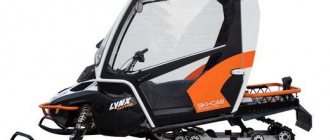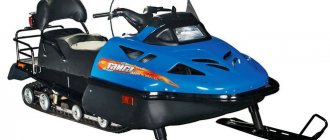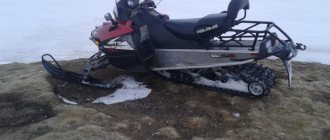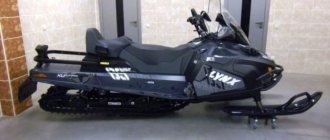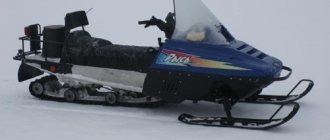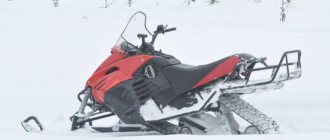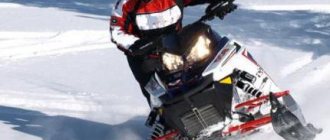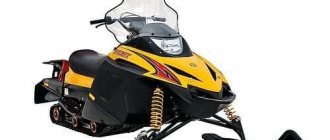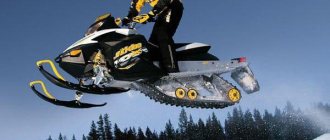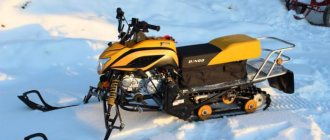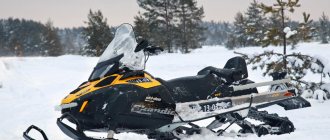BRP Lynx is a popular brand of modern snowmobiles created specifically for the harsh and snowy winters of Europe and Russia. The company's products are distinguished by cross-country ability, maneuverability, reliability, long service life and stylish design. All BRP Lynx models are equipped with economical and powerful engines up to 1200 cc and a special suspension. The brand’s equipment is perfect for winter hunting, fishing or long trips.
BRP Lynx 69 Yeti Army 600 E-TEC is a modern utilitarian type snowmobile, representing a new line of the brand. The device is based on the modern LXU platform. The model is designed to perform tasks of increased complexity in mountainous areas and in extreme situations (originally planned for use in the army). Even in the most difficult conditions, the snowmobile continues to work.
The long studded track guarantees excellent traction on icy surfaces and loose snow. A powerful battery allows you to start the snowmobile in severe frosts. Additionally, the equipment is equipped with a manual starter. The 2-speed transmission and special suspension design make the snowmobile easier to control, allowing you to maintain control under any conditions (transporting a heavy load or driving in reverse).
Video
Compared to the younger family (Lynx 59), the Lynx 69 Army 600 series received improved skis and linings. Due to this, the movements became more precise. The steering remains virtually unchanged. The main innovation was the steering column with instant tilt change (the option was previously available exclusively on top versions). The switches and buttons remain the same (as ergonomic and comfortable as possible). The snowmobile is equipped with a one-piece windshield that protects from wind and branches. There is also a large trunk for various items.
The BRP Lynx 69 Yeti Army 600 E-TEC package was developed specifically for emergency services, and therefore includes many interesting things. These may include spark plugs, a rear case, light bulbs, a reinforced bumper, a tablet, a knife and other useful equipment. The basic configuration includes:
- steel steering wheel with curved handles and 4-position adjustment;
- high rear view mirror;
- large windshield;
- towbar;
- tachometer;
- heated handles;
- fuel level indicator;
- electric starter;
- multifunctional digital information center with display;
- passenger seat with backrest.
The snowmobile is offered in 2 colors: camouflage and gray-black (same price).
BRP Links 69 Army 600 E-TEC is a modern and reliable device designed to work in the most difficult conditions. The main consumers of this model are lovers of hunting and extreme recreation.
Design and construction
Links Armeets V800 is built on the BRP Yeti II platform, which is characterized by a powerful motor created specifically for increased loads. The unit settings allow you to tow a sled with large luggage (up to 800 kg) or pull small cars out of snow captivity. The snowmobile's fuel tank is designed for 42 liters, the oil tank is designed for 2.8 liters.
| Dimensions | |
| length | 3070 mm |
| width | 1155 mm |
| height (with windshield) | 1370 mm |
| ski track | 900 mm |
| ski width | 200 mm |
| Track dimensions | |
| length | 3968 mm |
| width | 600 mm |
| lug height | 32 mm |
In addition to the standard options for such models (high windshield, heated grips, towbar, trunk), the snowmobile has:
- spare set of spark plugs;
- Belt variator;
- removable seat back;
- fuel sensor;
- speedometer;
- electric starter.
The standard package also includes a sealed bag for documents or maps, an axe, a tow rope, a knife and a set of spare lamps. A protective case is installed on the lattice trunk.
Element characteristics:
Transmission:
- variator drive pulley – TRA 3;
- variator driven pulley – QRS SS;
- reverse – mechanical (2-1-NR);
- Braking system – hydraulic with steel brake hoses with reinforced structure. The main brake cylinder is made of plastic.
Chassis:
- front suspension type – LTS (telescopic);
- front suspension shock absorbers - MC;
- front suspension travel – 160 mm;
- rear suspension type – PPS-6900/PPS-5900;
- rear suspension shock absorbers – HPG 36/HPG 25;
- rear suspension travel – 340 mm.
Snowmobile BRP 800
69 YETI ARMY 800E-TEC is a snowmobile that is designed for people who move only forward. The equipment simply does not tolerate defeat, has incredible cross-country ability and can pass through the most difficult areas. A powerful engine along with a modern design and a proper shock-absorbing system is attracting more and more attention. There can be no compromises when it comes to a 164 horsepower sled. Only the most difficult landscapes and low temperatures are ideal conditions for operating the snowmobile in question. The build quality of the snowmobile is at the highest level, all the main components and parts are created in such a way that they do not fail at a crucial moment, thereby leaving the driver alone with nature. Let's look at the technical characteristics of the "predator".
Engine
For the BRP Lynx 69 Yeti Army 600 E-TEC snowmobile, the economical and powerful Rotax 600 E-TEC 2-stroke unit was chosen. Among the advantages of the new motor are:
- savings on fuel (average consumption - 20 l/100 km);
- less harmful emissions. Among 2-stroke engines, the motor is considered the cleanest;
- small mass. The unit weighs less than analogues from Yamaha (declared weight - 188 kg);
- saving oil, which will have to be added 1-2 times per season. The reason for this is the new electronic oil pump;
- quick start and acceleration. The service life of the candles is 3 years. The engine will process the cylinders on its own before summer storage.
The Rotax 600 E-TEC engine is based on the popular Rotax 600 SDI unit. The new product received an improved exhaust valve system and direct fuel injection. The power plant is lubricated with pure oil, and the intake, exhaust and combustion systems have been modified to minimize oil use. E-TEC technology makes the engine even better than similar 4-stroke engines.
The cooling system of the Rotax 600 E-TEC is mixed. There is a radiator under the hood and a cooler in the tunnel. A similar kit, together with an electric fan, maintains the motor temperature at the same level. The unit is started using an electric starter or manually.
Rotax 600 E-TEC Engine Features:
- working volume – 594.4 cc;
- rated power - 117 hp;
- number of cylinders – 2.
The fuel tank holds 45 liters of fuel.
Snowmobile brp lynx yeti pro 800
Their main task is not to let you down in the most difficult situation. Our review is dedicated to the simplest, most unpretentious and affordable snowmobiles.
In literally all characteristics, except perhaps power, Bravo can be put on a par with products from domestic manufacturers. The only striking difference between the “Japanese” and the “Nasheprom” products is the quality of workmanship and reliability. Even the very first argument of many supporters of domestic products: “But it breaks, so what to do? And “Buran” I can fix in any snowdrift ...” in this case it does not work, because the design of the “bateshka” is perhaps even simpler than the same “Lynx” or “Buran”.
Of course, Bravo is far from a record holder in terms of traction and dynamic characteristics. The declared maximum speed is only 70 km/h, and you can’t attach a sled with hundreds of kilograms of luggage - it won’t pull it out. But it’s difficult to find a more suitable car, say, for going fishing or patrolling ranger grounds.
Viking III is perhaps the most balanced “price-quality-comfort” utility from the “three tuning forks”. Unlike the truly spartan BR250T, everything in this device is truly mature, from the engine to the equipment. A two-cylinder engine of more than half a liter capacity produces 46 horsepower, although modest, but quite acceptable for ordinary household tasks, and the variator, in addition to reverse, is also equipped with a reduction range. Plus a wide track with good grip, allowing you to move through snow of any depth with maximum load - all this makes the Viking III an ideal working machine for any task. It can become a multifunctional transport at a ski resort, a shuttle for oil workers in the Arctic, and an excellent assistant for hunters.
Polaris. This American company was one of the first to start selling its equipment in Russia. That is why its snowmobiles are, perhaps, more often than others found in the snowy expanses of our homeland. Both amateurs and professionals appreciated their quality and reliability. According to many experts, it is Polaris that is most suitable for operation in Russian conditions. The reason is not only the reliability and unpretentiousness of the equipment, but also the availability of spare parts, and not only original ones. In neighboring Finland, for example, Polaris snowmobiles are so popular that a whole industry has emerged around them, offering not only all kinds of tuning and accessories, but also a full range of spare parts. This, of course, speeds up and reduces the cost of any repair, since spare parts are much closer to transport. According to the traditional classification, snowmobiles designed for movement in deep snow are called Wide Track; the main feature of this type of equipment is a wide track. Polaris utility vehicles bear exactly this name, but in a slightly modified form.
This model is the most affordable in the company's line of utilitarian snowmobiles. But, unlike Yamaha, the “American” does not at all pretend to be a “gray mouse”, both externally and internally. The peculiarities of the national character are reflected. After all, Americans manage to make even such prosaic things as long-distance trucks and tractors beautiful - just remember Mack tractors. The picture is the same with snowmobiles: Widetrak LX, although the youngest, looks very daredevil. It is immediately clear that not only layout engineers, but also designers worked on the appearance of the car. Although this is not the main advantage of a utilitarian car, it is still nice. As for the main thing, everything is in perfect order here with Polaris: with an engine displacement that is 50 cm3 smaller than that of the Yamaha Viking III, the power of the “American” is almost twice as high - 85 hp. First of all, this is achieved by installing a separate carburetor for each cylinder. Due to the large power supply, the engine was also equipped with a liquid cooling system. For the same reason, a mechanical brake is no longer enough here - it is hydraulic.
Match the engine and suspension. The Americans did not skimp on comfort: the skis are mounted on a modern IFS lever suspension, and the rear adjustable suspension with articulated extension has two shock absorbers - front and rear. Of course, the Yankees did not forget about the much-needed “utilities”, such as a lattice trunk at the rear, a large underseat space for luggage and a towbar. The passenger seat is equipped with an adjustable backrest, and the steering wheel handles and gas trigger are heated. The basic package even includes a 12 V socket.
BRP-Lynx
Yeti Pro 550
The Finn is equipped with a two-cylinder two-stroke Rotax engine (another greeting from BRP) paired with a variator equipped with a Syncro system, which softens transmission jerks when starting off, even if there is a very heavy trailer behind it.
“Bigfoot” also has a brother, produced on the same Yeti II platform, the Yeti Pro Army V-800 four-stroke. Externally, the cars are almost indistinguishable, but under the hood of the Army Man there is a completely different filling hidden - a Rotax V-810 engine, designed specifically for snowmobiles. The impressive displacement and settings, focused more on traction than on power, allow the snowmobile not only to easily drag sleds with “killed bears”, but also to pull cars and small SUVs out of snow captivity.
*Prices in Moscow at the beginning of October 2009.
REVIEWS ABOUT THE YETI PRO ARMY V800 SNOWMOBILE
20 cm of snow fell and I decided to start breaking in the snowmobile. I rode for 2 days. Traveled 100 km. The air temperature was −3, −5. Burned 20 liters of gasoline. Impression. The sound of the engine at idle is lovely. The sound of the engine at low speed is significantly quieter than the 2T. It was snowing. Moving slowly, 20 km per hour, several times a day I raised sleeping goats at 20 meters. But when driving at a speed of more than 40 km/h, the engine sound resembles a K700 or a turbodiesel without a muffler. In addition, some vibration appears. Is this how it should be? I have not overclocked it to more than 60 yet. Still, there is not enough snow, but at 40 it breaks the goose into slipping. The honeycombs for supplying air to the cooling radiator under the hood become clogged with snow. The electric cooling fan turns on very often. What's wrong with the temperature? It's cold, but the overheating light didn't light up. The temperature indicator will have to be installed separately. It steers very well, but it's hard. At the end of the trip, my arms get very tired. For such a weight, the standard handles seemed small in diameter, although 2T was enough for the Army. I'm thinking of making it thicker. I really liked the low end traction. For this I am ready to forgive the apparatus its HELLO weight. I appreciated the opportunity to move off smoothly, with tension, without slipping, when moving over fallen trees and leaving unfrozen streams, where I managed to fall a couple of times. Knocked it over twice. Once in a field on a hummock, and the second time in a rut. Both times I was able to lift it myself within 5 minutes. But I almost tore my butt. You should at least buy a hand winch. Driving without a winch seems like an adventurism. Very comfortable fit. The trunk is just a dream. And a chainsaw gets in and a sack with an unbutchered goat (I don’t like doing this in the field) and much, much more. So far I am very pleased with the device!!!
Denis, Novosibirsk
Today I also went out to test my Yeti Pro V-800 for the first time. I started quietly, 20-30 km. My wife is in the back seat. Snow 15-20 cm. Sitting along the field along the forest, we arrived at the place where barbecue was being prepared. The weather is whispering, there is snow without wind... I have caught God by the beard!!! While the barbecue was being prepared, I took the gun, twirled it for a long time, where to place it (I’m not a great hunter, so, for bottles, occasionally for ducks, capercaillie, braids, four-legged animals, my hand doesn’t rise, and I don’t really need it anyway). The best thing is that it’s there and it’s like I’m going to get some prey on business. I hung it on my chest, I couldn’t think of a better one. I drove off for half a kilometer, a small slope with rare bumps began, the speed was 10-15 km. It seemed like he was coaxing, but he didn’t get impudent. Then, suddenly, I’m flying... With a gun, it’s a pity there was no one nearby, take a photo. Snezhik is working, he didn’t fasten the cap. While I was floundering, half a minute passed before I turned it off. Although I trained, I memorized the sequence of actions in such a situation. Well, I think, p..t., we need to shoot so that our friends ride on Buran to the rescue. What if they think that I’m fucking with the scythes? On the forum in my brain, I’ll pick up one dick. The winch is in the trunk, in the bag. I forgot about her. And there were no trees nearby. In short, out of fright, he raised it three times with an interception. I think the freak ruined the new device. I examined it, everything seems to be intact. I started it up and put the gun in the trunk. As I felt, I drove off and after about 40 meters I fell onto my right side again. Yes, this time I fastened the pin, but the engine is running again, and the pin is in place. Vomited in the wrong place. I turned it off more confidently, shook it and, using the reverse force of inertia, picked it up right away. I started it, but it kept squeaking and complaining about a malfunction, but it didn’t gain any momentum. Well, I think I’ve completely ruined it now. It was a good book, I found the problem, blah, I started to respect myself. When I was flying, and I was still pushing off the snowball in flight so as not to crush it, even though the plug remained in place, apparently I pulled well, the contact was broken. I pushed it into place more tightly and everything worked. Didn't fall again, but disappointed. So much for SWT, but what if my wife were traveling with me? I drove off the slope and drove straight back. After cooling down, I rode around the field for two hours, accelerating to 70 km, not at full throttle. I also noticed the noise after 30-40 km. This is my first snowflake, in the team of 3 Buranas, compared to them it’s quieter of course, but I expected more. They only took me around on Buran; I couldn’t cope with its helmsman. I tried it a couple of times and spat in the sled or in the back. Compared to him, of course it’s better. I’m starting to realize one of the catchphrases of the forum: “The gasket rules!” Will learn…
Yuri, Krasnoyarsk region, Achinsk
Easy easy, don't even be puzzled. When the equipment is stationary or stuck, it is heavy and unliftable, but while driving it balances easily..... Just don’t stupidly sit backwards where balancing is required, if you think it’s a windtruck, then you can sit in a car and drive, no Of course we have to work. Or are you going to convince me that on a completely flat surface he just turned over? Having understood the behavior, previously, under the terrain and inertia, use your hands on the steering wheel to correctly drive it, tilt it, and push it if necessary, you can believe me that while driving, this is all done easily, you just need to feel the balance and ride on it, but anything falls and overturns. If you notice that the terrain is like this, and the snowmobile moves only if it transmits traction correctly with the propulsion system. Riding a snowmobile is moving from point a to point b, but provided that the mechanism has a conditionally horizontal position anywhere (with the exception of driving on slopes or along) A sufficient supply of inertia and speed is required there so that sufficient forward movement remains (this is also a balance, you need to feel it too) And if the forward movement is lost, you need to jerk the snowmobile around with its nose down, you’ve passed the critical moment of loss of movement and you’re digging. When you go uphill at the limit, the track must be unloaded as much as possible by rocking and pulling to the sides, including the utilitarian snowmobile. This is also a balance of swinging, throttling and maneuvering on a slope, he needs to learn to feel it, it’s not easy to describe it. A simple example is a plain, you approach a hill. The first thing is to try (especially on a windtruck) to drive onto the slope at right angles to the plane of the slope. Then the track will have sufficient support to form good traction. Make sure that the entry is quite smooth, otherwise you will stick your skis and yourself into the steering wheel, if not, look for another place or enter at an angle, balancing on one ski, pointing (hanging) the snowmobile into the inside of the slope with the throttle, cutting off the track area conditionally parallel to the plane of the earth. Therefore, when you look at the territory, you almost always have to draw a path in your head in advance, but it is drawn with experience, approximately whether you can drive there or not, and if you don’t enter, then you know in advance where you will turn, as if you model it in advance. At the same time, when you are going up a hill or in loose snow, you should always know the escape route, just sawing and digging you will travel no more than a kilometer in a day, but up the hill you just need to turn around and do it again, dig there and move to the top, perhaps on a mountain climber or not all slopes. And at the same time, you need to understand the snow, feel its load-bearing capacity, and at the first signs of getting stuck and getting stuck, look for or make a loop to get onto the track or crust, etc. Riding a snowmobile is not a smile on your face from speed and drink. This is normal active physical labor as a derivative of analytics and modeling of mechanism behavior in a constantly changing environment. And also so that they would understand what I’m talking about. A snowmobile weighs 250 kg, conventionally, a person in a package, conventionally 100, two conventionally 200. What am I talking about? The fact that even in the first case, the mass of a person is a determining and influencing factor in the behavior (or rather, in a constant horizontal position) of a snowmobile. What can we say when there are two riders. This is all conditional, of course, but the general principles are still clear: you can’t sit while turning (on a rolled one) or sink it inside on powder, because with your inertia and your mass, you will eventually turn it over. And if you say that we are hanging and training, I will simply tell you what that means is not enough for this situation (speed, radius and load-bearing capacity of the snow). This is just the amount of experience and momentum. In some places you have to get off of him, push him behind the wheel if he’s driving alone and get in with you, in some places you have to drive slowly, slowly, standing with one foot on the shock absorber joint of the front suspension, heaving and tilting in order to make your way along some kind of ravine or washout, and there’s not enough room for a high-speed maneuver and... and acceleration to the horizontal exit predicted for the next start. There are a lot of nuances here. And the V800 is a really light and controllable snowmobile, but like all snowmobiles it has its own individual qualities, they need to be felt and riding is possible only by tracking the balance of these qualities.
Yeti Pro Army V-800 snowmobiles are discussed here
Buy Lynx Yeti Pro Army V-800 snowmobile
Sources
- https://www.zr.ru/content/articles/121527-trudagi_snegohody_2010/
- https://www.snow-mobiles.ru/lynx/otziv-yeti-pro-army-v800.shtml
Price
The cost of the new BRP Lynx 69 Yeti Army 600 E-TEC starts from 1.09 million rubles. Older model year models without mileage can be purchased cheaper.
It is problematic to buy a used snowmobile of this modification, since its sales began relatively recently. Average prices:
- 2013-2014 – 690,000-7,800,000 rubles;
- 2015-2016 – 890,000-1,100,000 rubles.
Price and where to buy
The cost of the new BRP Lynx 69 Yeti Army 600 E-TEC starts from 1,359,000 rubles. Snowmobiles of an older year with mileage can be purchased at prices ranging from 890,000 to 1,100,000 rubles. Used equipment usually requires repair.
Prices for spare parts for the BRP Lynx 69 Yeti Army 600 E-TEC snowmobile:
| Original pistons | 9500 rub. |
| Suspension spring | 1450 rub. |
| Front variator shaft bracket | 4500 rub. |
| Steering shaft | 10500 rub. |
| Brake pads | 5300 rub. |
| Underbody protection | 11000 rub. |
| Extended brake hose | 2000 rub. |
| Cylinders | 11600 rub. |
| Throttle grips | 13300 rub. |
| Rod end | 1900 rub. |
Owner reviews
- Ivan, Perm region: I bought an “army soldier” at the beginning of the year. Currently the mileage is just over 430 km. The main part of the journey was along a compacted road, periodically stopping into the forest. The snowmobile has a huge number of advantages. The equipment accelerates quickly, but the speed is not felt at all. At the same time, consumption does not exceed 25 l/100 km. Ride comfort is excellent. The only thing I didn’t like was that the Lynx 69 Yeti Army 600 E-TEC sometimes sank too much even in relatively simple areas. Also, a strange noise was periodically heard when re-gasping. I didn't find any other negative features.
- New2015: BRP Lynx 69 Yeti Army 600 E-TEC is one of the best snowmobiles today. In most respects it is superior to other utilities. I won’t describe the huge number of advantages of this model; I’d rather tell you about the disadvantages that I discovered during the year of use. On bare ice, control becomes difficult, and sometimes you even lose control of the device. The box shifts rather reluctantly. Compared to Japanese models, the clarity is much worse. A basic track with a regular tread is not suitable for extreme sports. And most importantly, the snowmobile is very expensive (both cost and maintenance).
- Oleg, Vologda: I drove the Lynx 69 Yeti Army 600 E-TEC for almost 260 km. I am pleased with the maneuverability and power of the snowmobile. Inconveniences appear only in deep snow. When turning left on bumps or hillocks, it is difficult to reach the gas. Another point is that there is no indicator that the brake lock is engaged, so sometimes you forget about it. There are no complaints about the quality and components - everything is perfect. I filled the “army soldier” with 92-grade gasoline and drove it perfectly. There is enough power always and everywhere; a shovel is simply not needed for this snowmobile. A snowball rolls two people with a load very confidently. So far I'm happy with the purchase.
- Bumper_11111: I bought a Lynx 69 Yeti Army 600 E-TEC six months ago. For lovers of fishing or hunting, this is the ideal snowmobile. I really liked the engine. Although it is a 2-stroke, there is no “stink” at all. The noise level is average, but the engine is incredibly powerful, making the snowmobile both fast and high-torque. The mileage is currently 1156 km. Absolutely no problems. Goes everywhere, pulls a huge load. During the first season I only changed the slicks after 610 km. I am very pleased with the equipment, it is now in conservation, and will soon open a second season.
Reviews
- Yaroslav, Smolensk. The machine hasn’t caused any problems so far; I’ve been using it for two years. The snowmobile is quite playful, despite its low power. True, at high speeds the engine makes a lot of noise and vibrates – apparently, this is the case with all small cars. I was pleased with the torque reserve, thanks to which the dynamics and acceleration capabilities remain at the same level. This does not depend on the load capacity, passengers, etc. Even when fully loaded (two people and cargo), the car starts and accelerates confidently. Even three people can travel together. The device does not seem to feel the load, and at the same time it is quite economical. The suspension is quite strong, the opening is almost not felt. I was pleased that the snowmobile could be started on the first try even at minus 30 degrees. But the disadvantages can be noticed immediately, that is, before purchasing. We are talking about high cost. But if funds allow, we should definitely take this model.
- Nikolay, Kazan. It’s clear that any fast and extreme device from a prestigious brand is not a cheap pleasure. The BRP Lynx Yeti Pro Army V-800 snowmobile is just that. Naturally, I would never buy a new car like this. So I went to the used market and found a suitable copy. I decided to save money and at the same time get a high-quality device from Finnish developers. The machine has been in operation since 2021, I’m using it for the second season. The equipment is ideal for driving through deep snowdrifts. My brother and I travel regularly, and at the same time we take with us a sled with a load weighing 200 kg. In such a loaded state, the snowmobile rides confidently, without any overheating. I note good directional stability, although sometimes there are cases when the device fails - this is probably due to the high center of gravity and large mass. I mean that there are problems with cross-country ability in deep snow - for example, if you don’t clean the suspension for a long time. Fuel consumption does not exceed 15 liters per 100 km. In general, I made the right choice and was even more convinced that it is possible to take a closer look at used equipment. Maintenance costs are minimal, which is very cool.
- Konstantin, Irkutsk. The BRP Lynx Yeti Pro Army V-800 snowmobile was purchased last year. The car was put into use almost immediately. I quickly got used to the handling and behavior of the snowmobile. In general, the car is quite stable at high speed, although in such extreme modes vibration is felt on the steering column. I don’t even understand where the vibration comes from - at this moment I’m more focused on the road, because sometimes I have to go around difficult obstacles - trees, stones, hillocks, etc. I noticed a flaw in the suspension - it’s not too energy-intensive and quite stiff, but on the other hand On the other hand, this had a beneficial effect on sharp handling. At first my hands got tired, but then I got used to it. There were times (at least twice) when I miraculously kept the snowmobile in a deep snowdrift - it could have ended up capsizing. In low gear, the snowmobile pulls perfectly and carries absolutely any load. I liked the roomy trunk. I can say that the snowmobile turned out to be ambiguous. It is moderately practical and sporty, but is more suitable for leisurely driving due to problems with stability on uneven roads. If it were cheaper, then there would be no questions.
- Vladimir, Novosibirsk. The second winter is coming to an end, and in two seasons I have driven more than seven thousand kilometers on the Army. The car is economical in terms of fuel consumption, even at maximum load. According to my measurements, with two passengers (the third is the driver) and a load weighing 300 kg, the BRP Lynx Yeti Pro Army V-800 Snowmobile consumes about 24 liters per hundred. Of course, there are also disadvantages, although this is somewhat strange for such an eminent car, and even with a rather weak engine. The snowmobile has enough cross-country ability, and even at minus 42 degrees the device starts without problems. But due to its heavy weight, the snowmobile accelerates slowly, and it is also clumsy. I have a suspension with soft settings, and not configured for aggressive driving. As a cargo or passenger carrier, this snowmobile is an excellent option, but it is clearly not suitable for extreme adventures.
Appearance
It's nice to see the results of the work of the company's designers, who keep up with the times. The design is modern with a touch of sporty style. The body of the equipment is covered with high-strength plastic, which can withstand various mechanical impacts. That is, in the most extreme conditions, the pilot can be confident in the safety of the hull if it falls on its side or even capsizes.
In front you can see two ski tracks widely spaced between each other. This placement allows you to best increase the stability of the snowmobile many times over. In the bow you can see a power bumper, which will take the blow in the event of a collision with an obstacle (stumps, bushes, logs and stones). The front headlight ensures driving in complete darkness, reliably illuminating the required area of the snowy road surface. The windshield will protect the driver from the effects of oncoming wind and snow. Overall, the snowmobile looks very harmonious and stylish, which is important.
In the back there is a trunk for non-bulky items. To enable cargo transportation, a towing device is installed. The seat consists of a thick layer of padding that minimizes discomfort during long rides.
Landing
The landing of the snowmobile is designed in such a way that the driver, even with a tall stature, feels as comfortable as possible. In this case, there is no numbness in the back or legs. The same applies to the passenger, only a comfortable backrest will be a bonus for him. We can say that a successful landing allows you to properly control the equipment. In a standing position, the driver can easily maneuver the equipment, which is especially important in dense forest conditions.
